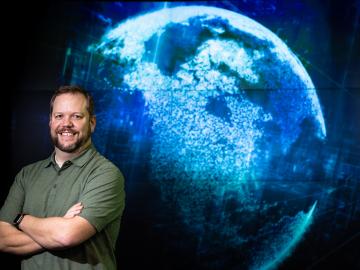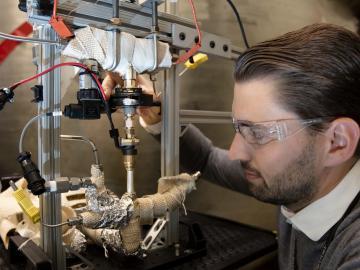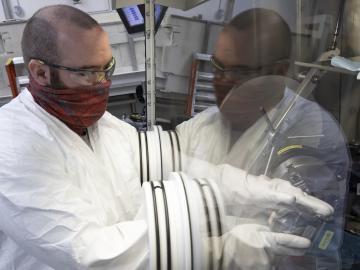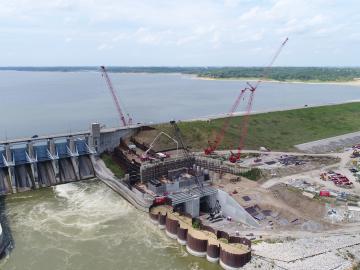
Filter News
Area of Research
- Advanced Manufacturing (2)
- Biological Systems (1)
- Biology and Environment (7)
- Computational Biology (1)
- Computational Engineering (2)
- Computer Science (6)
- Electricity and Smart Grid (1)
- Energy Science (40)
- Fusion and Fission (6)
- Fusion Energy (5)
- Isotopes (4)
- Materials (12)
- Materials for Computing (2)
- National Security (4)
- Neutron Science (9)
- Nuclear Science and Technology (10)
- Quantum information Science (1)
- Sensors and Controls (1)
- Supercomputing (17)
- Transportation Systems (2)
News Topics
- (-) Big Data (14)
- (-) Biomedical (15)
- (-) Exascale Computing (5)
- (-) Grid (15)
- (-) Machine Learning (6)
- (-) Nuclear Energy (23)
- (-) Security (5)
- (-) Space Exploration (8)
- (-) Transportation (35)
- 3-D Printing/Advanced Manufacturing (42)
- Advanced Reactors (9)
- Artificial Intelligence (20)
- Bioenergy (24)
- Biology (25)
- Biotechnology (6)
- Buildings (13)
- Chemical Sciences (7)
- Clean Water (13)
- Composites (9)
- Computer Science (71)
- Coronavirus (10)
- Critical Materials (4)
- Cybersecurity (12)
- Energy Storage (30)
- Environment (62)
- Frontier (6)
- Fusion (14)
- High-Performance Computing (19)
- Isotopes (13)
- ITER (4)
- Materials (32)
- Materials Science (44)
- Mathematics (1)
- Mercury (5)
- Microscopy (16)
- Molten Salt (1)
- Nanotechnology (16)
- National Security (7)
- Neutron Science (44)
- Physics (11)
- Polymers (7)
- Quantum Computing (5)
- Quantum Science (22)
- Statistics (1)
- Summit (18)
Media Contacts

Xin Sun has been selected as the associate laboratory director for the Energy Science and Technology Directorate, or ESTD, at the Department of Energy’s Oak Ridge National Laboratory.

A method developed at Oak Ridge National Laboratory to print high-fidelity, passive sensors for energy applications can reduce the cost of monitoring critical power grid assets.

Twenty-seven ORNL researchers Zoomed into 11 middle schools across Tennessee during the annual Engineers Week in February. East Tennessee schools throughout Oak Ridge and Roane, Sevier, Blount and Loudon counties participated, with three West Tennessee schools joining in.

Cory Stuart of ORNL applies his expertise as a systems engineer to ensure the secure and timely transfer of millions of measurements of Earth’s atmosphere, fueling science around the world.

For a researcher who started out in mechanical engineering with a focus on engine combustion, Martin Wissink has learned a lot about neutrons on the job

On Feb. 18, the world will be watching as NASA’s Perseverance rover makes its final descent into Jezero Crater on the surface of Mars. Mars 2020 is the first NASA mission that uses plutonium-238 produced at the Department of Energy’s Oak Ridge National Laboratory.

Thirty-two Oak Ridge National Laboratory employees were named among teams recognized by former DOE Secretary Dan Brouillette with Secretary’s Honor Awards as he completed his term. Four teams received new awards that reflect DOE responses to the coronavirus pandemic.

A better way of welding targets for Oak Ridge National Laboratory’s plutonium-238 production has sped up the process and improved consistency and efficiency. This advancement will ultimately benefit the lab’s goal to make enough Pu-238 – the isotope that powers NASA’s deep space missions – to yield 1.5 kilograms of plutonium oxide annually by 2026.

A new Department of Energy report produced by Oak Ridge National Laboratory details national and international trends in hydropower, including the role waterpower plays in enhancing the flexibility and resilience of the power grid.

Fuel economy can take a tumble when temperatures plummet, according to the Department of Energy’s 2021 Fuel Economy Guide. Compiled by researchers at Oak Ridge National Laboratory, the guide includes several tips to improve a vehicle’s fuel performance.


